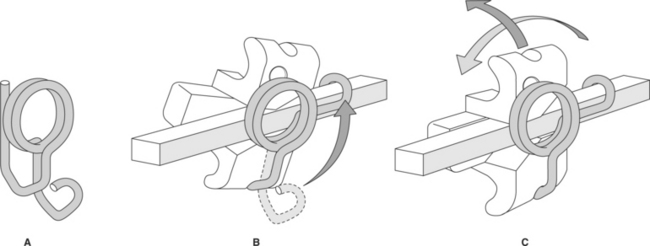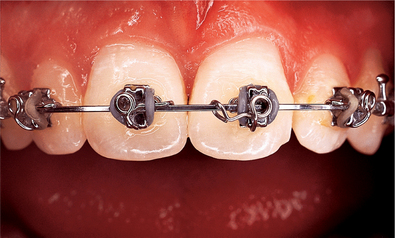CHAPTER 4 Auxiliaries
In its early days, Tip-Edge was used with a host of different auxiliaries. Many of these were Begg derived and designed for orthodontists unfamiliar with rectangular wire. Nowadays, however, the modern orthodontist wants to eliminate elaborate wire bending. With Tip-Edge, the whole problem became greatly simplified with the introduction of preformed rectangular archwires. Apart from the Power Pin™ (a traction hook) and the occasionally useful Rotating Spring, the erstwhile Side-Winder spring answered every need in terms of root uprighting and torquing. For Rx-1 users, it still does. However, now that we have Plus, even the Side-Winder has become redundant during that final torquing and uprighting phase of treatment, when virtually every bracket previously required a spring to achieve its prescribed finish.
A single nickel–titanium archwire running through the deep tunnels is therefore the new auxiliary, which does the job formerly undertaken by all the springs. This does not make the Side-Winder obsolete, however. Even though its use is now occasional, rather than routine, it retains an essential function in the earlier stages of treatment in specific situations. These include Power-Tipping to prevent unwanted proclination of lower incisors in Stage I (Chapter 10) and ‘braking’ to increase anterior anchorage and correct centrelines, both in Stage II (Chapter 11). In all three of these applications, the Side-Winder is working in the tipping plane only, on round wires rather than rectangular.
The Side-Winder
This used to be the everyday ‘workhorse’ among Tip-Edge auxiliaries (Fig. 4.1). Primarily, it generates mesio-distal root movement and, with Plus, this is all that will be required of it. For those still using the Rx-1 bracket, the Side-Winder is well proven to produce torque correction as well, when used in conjunction with rectangular archwires. It is made in .014 inch high tensile stainless steel wire.
So called because it carries its coils alongside the archwire, over the bracket face, the Side-Winder was a significant improvement over the original Begg type uprighting spring, which carried its coils gingivally. Because the coils of the Side-Winder are concentric with the point of second order rotation of the bracket, its action is mechanically more efficient, and its hook no longer travels noticeably along the archwire as the tooth uprights. It is also more aesthetic and easier for the patient to keep clean, although it does inevitably add to the labial profile of the bracket.
The Side-Winder has undergone considerable development since it was first introduced, although its mode of action remains the same. Original versions were retained in the vertical slots by bending the long gingival tails 90 degrees, which made them fiddlesome to remove. It was subsequently realized that the spring pressure of the activated arm reciprocally keeps the tail of the spring securely seated up the vertical slot, so that the long tails were deleted. However, by far the most significant improvement came with the so-called ‘Invisible Side-Winder’ (Fig. 4.2).
This is not strictly invisible, of course, although aesthetics are improved by the fact that the wire of the spring overlays the bracket and archwire so that, unless using ceramic brackets, the show of metal is scarcely increased. Perhaps of greater importance, it has several functional advantages. Firstly, it is retained in position by the elastomeric module, in addition to its own spring pressure. This greatly reduces the risk of detachment and also enables the modules to be changed, if necessary, without removing the springs. Secondly, because the bulbous hook has been greatly reduced, the spring arm has a wider range of activation than was previously possible (Fig. 4.3). Again for Rx-1 users only, the extra power of the spring is an advantage, particularly on incisors, when delivering the final torque prescription, but is unnecessarily strong for simple sec/>
Stay updated, free dental videos. Join our Telegram channel

VIDEdental - Online dental courses




